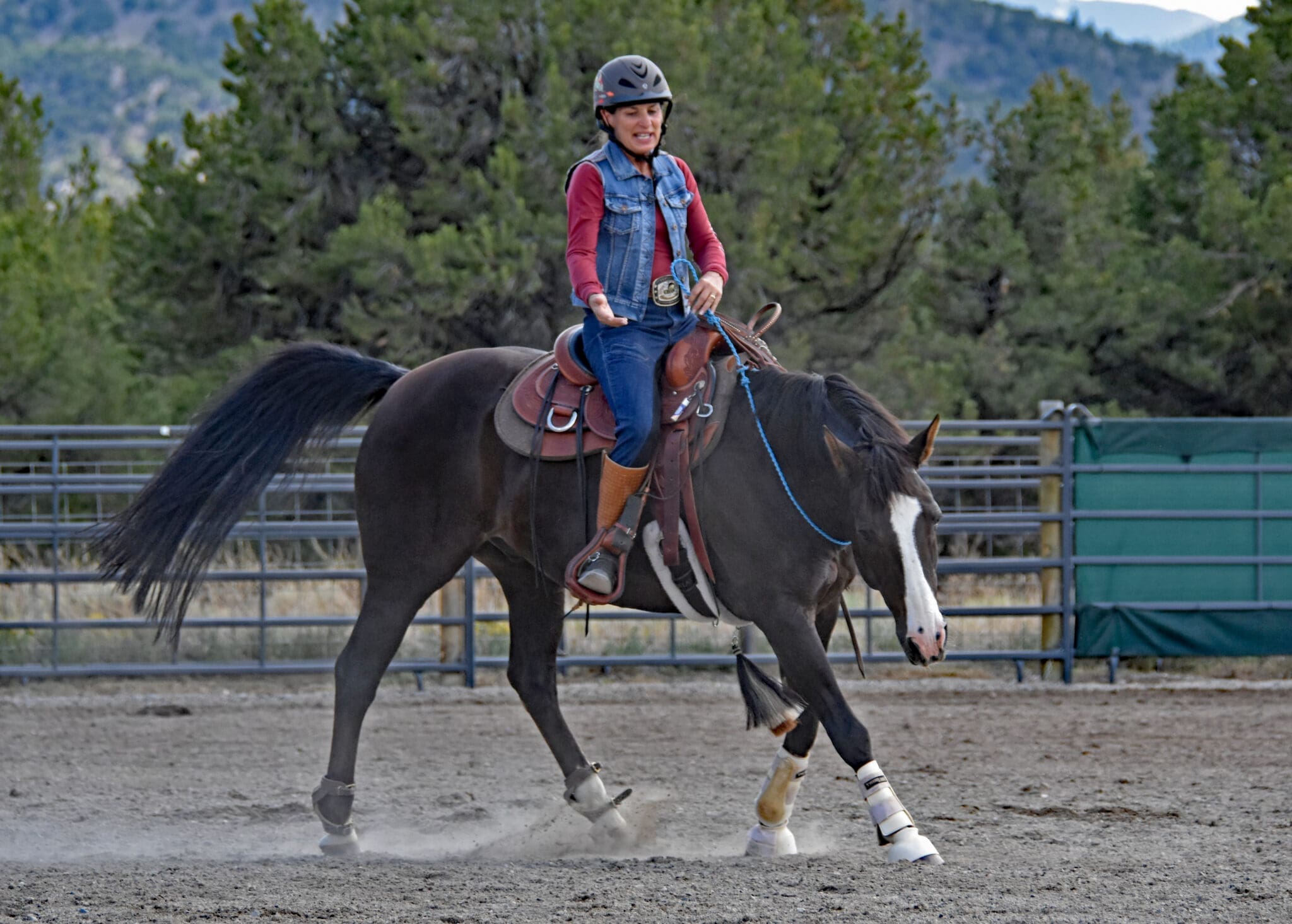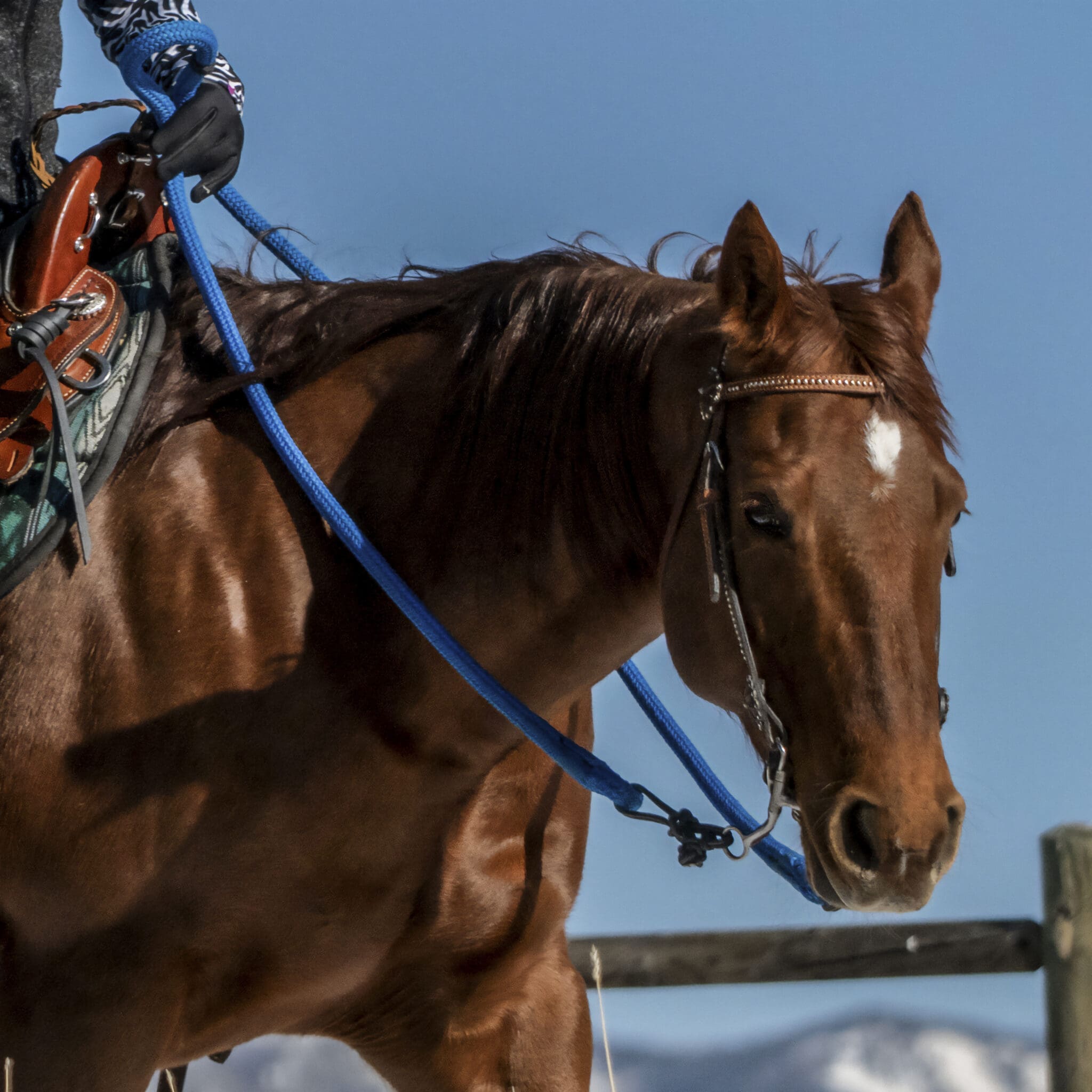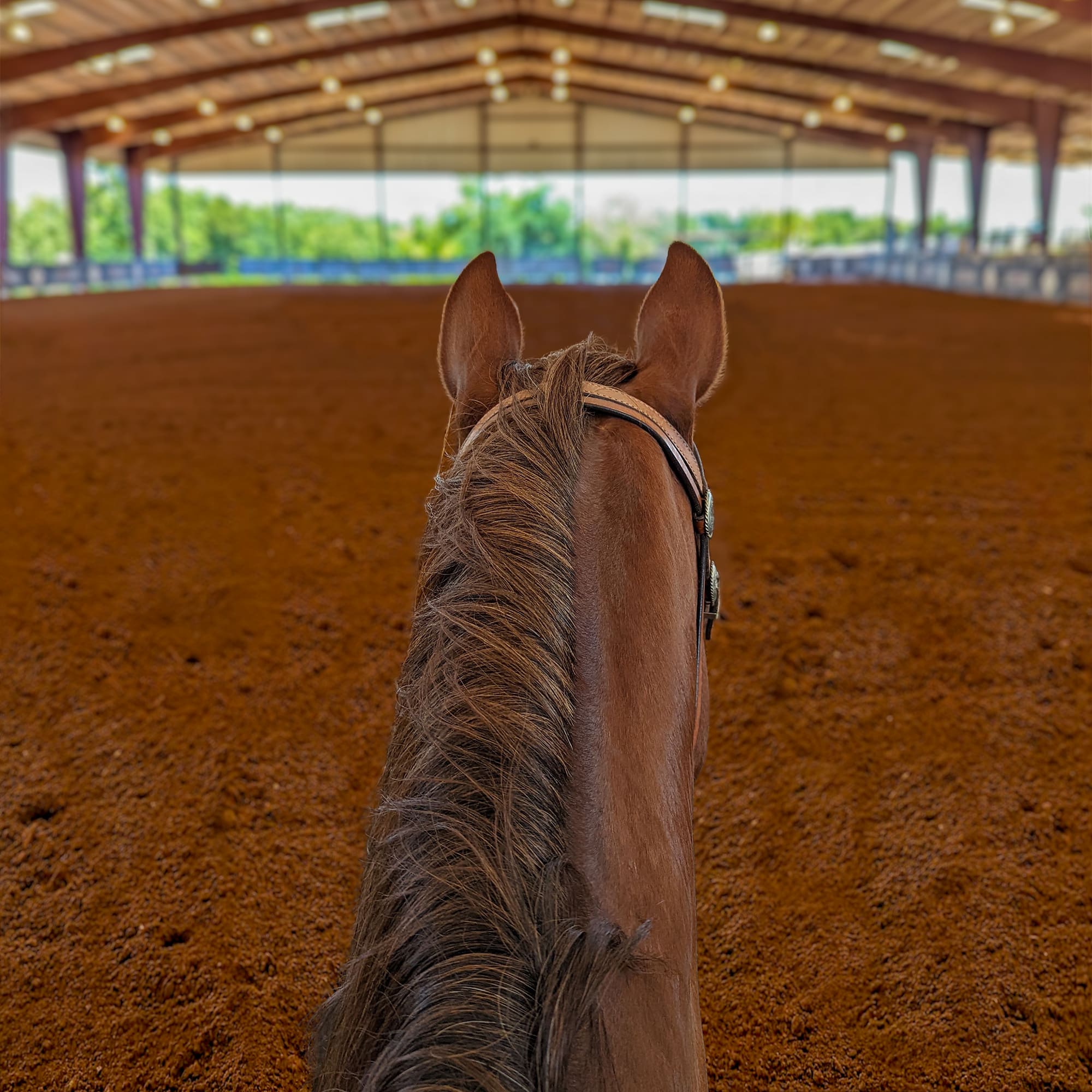
Unless you have the luxury of loading up your horses and heading to Arizona or south Florida for the winter, chances are good your riding activities have been seriously curtailed by winter weather. Whether you’re dealing with rain and mud, snow and ice, or sub-zero temps and bomb cyclones, the winter months can put the brakes on your horsemanship, if you let it.
This time of year, I hear a lot of frustration in the voices of the riders I coach online, because they have assignments they want to complete, but can’t do much with their horses until the weather improves. I grew up in Florida, where winter is the prime riding season, but after decades of living in the Rocky Mountains, 7800 feet above sea level, I can certainly relate to the winter whoas.
Truth is, there are plenty of things you can do to advance your horsemanship and increase your horse’s training, no matter how bad the footing gets. I think it’s important to keep your hands on your horses daily—for health reasons, for bonding, for leadership. Even if the winter weather restricts you from riding or groundwork, just grooming your horse in the barn, is time well-spent.
With just a little bit of ground with decent footing—in the barn aisle, a stall or the driveway—there are ground exercises that will keep your horse tuned into your signals and interested in what you have to say. Even with no footing at all, you can engage your horse enough to maintain the relationship (and authority) you’ve built.
The heart of winter is a great time to reassess your riding goals and your horse’s training. Evaluate and plan. And while you’re at it, think about improving your own self too! Horse sports are physically demanding, so fitness matters.
Finally, while there are some skills that require getting your hands dirty, there are additional avenues you can take to learn about riding, training, and horse behavior, too. Seek out writing and research from reputable trainers and equine scientists, or enroll in an online course—and winter is the perfect time for it. There’s a lot to learn about horses, and you need to gain knowledge every way you can.
Grooming Time is Bonding Time
Even if you can’t ride, it’s important to visit your horse and remind him of your relationship. Here in Colorado, some people hardly touch their horses all winter and by Spring, the horses are incredibly herd-bound. Getting your horse out, separating him from the herd and reminding him who you are, will help a lot.
Horses are mutually-grooming animals and they won’t groom on just any horse—it’s a behavior that only occurs between bonded horses. Giving your horse a thorough grooming reminds him of your special relationship and gives you an opportunity to remind him that you are still the one in charge.
I like to lay my hands over every square inch of my horse’s body, legs, neck and face. It’s especially important in the winter when their coats are long. Winter coats can mask health problems, like weight loss, plus, I like to feel the skin for any scabbing or injuries. I give my horses a thorough head-to-tail curry with HandsOn Gloves, just for this reason. I can kill two birds with one stone—while I curry and clean, I’m also feeling the skin and searching for sore spots. It’s a great massage for my horse and it mimics the way horses groom each other.
Grooming promotes health and well-being in your horse in many ways. Since I cannot bathe my horses all winter, yet we’re still riding and causing sweat buildup, I use a waterless bathing product called Miracle Groom. It also cleans manure and urine stains, without requiring any rinsing.
Get Grounded
Even if you don’t have suitable footing for riding or active groundwork, there are still things you can do with your horse in the winter to maintain your leadership and authority. As I said, just getting him away from the herd and alone for an hour or so will help. Tying your horse for grooming reminds him to be patient. You can work on ground tying exercises in the aisle of the barn.
If your driveway has some dry areas or even some snow-packed areas, you might be able to do some leading exercises with your horse to keep his ground manners sharp and to keep him tuned into you. Check out my Lead Line Leadership video for ground tying and other exercises to work on.
We try to keep our horses barefoot in the winter because it’s better for their hooves and an unshod horse has better traction in the snow and ice and is less-likely to get snowballs under his hooves. Hoof boots can be useful for shod or unshod horses, when you need more traction. If we have a horse that must remain shod in the winter for therapeutic reasons, we use snow pads for added traction and to prevent snowballs. Sometimes people use studded shoes or borium welded onto a steel shoe, for added traction in the winter.
If you have an indoor arena or suitable footing outside, you can include lungeing and circling work with your horse, which will not only keep him responsive, but also improve his fitness. If your riding activities are restricted in the winter months, spend whatever time you can on groundwork and relationship building activities. If you keep the relationship strong between you and your horse, you won’t miss a beat when the good weather finally arrives.
Goal-setting and Training Plans
Winter is a logical time to look forward and decide what you will accomplish with your horse in the coming year. Feats to accomplish, skills to master, trail rides, horse shows and clinics to attend. Get a calendar and fill that thing up. Set your long-range goals now.
The next step is to think about the skills and resources you will need to acquire, what steps you will take, how you will condition both you and your horse. Back-track on that calendar, thinking about how many weeks it takes to impact fitness, training and performance. What skills are you and your horse lacking and how long will it take to fill the holes? Break down the skills and set a training schedule.
Training and performance goals are accomplished over months and years, not hours and days. Looking forward, six to twelve months in advance, will help you chart a course. My Interactive Academy curriculum begins with assessing the current skill level of you and your horse, then setting realistic goals for the future.
For instance, if you’re planning to attend a multi-day rigorous trail ride in July, start by getting that date on the calendar. Calculate how many weeks and days-per-week of riding t will it take to condition your horse. Now you can back track on the calendar and set your riding goals.
Maybe you need to acquire some new skills for the trail ride… ground tying, tying to the trailer, trailer loading, crossing water, riding in a strange location. Identify the skills/experience/resources you need and make a plan. Take lessons, go on shorter rides, fill the holes with training—all that requires planning and time to accomplish.
In Pursuit of Knowledge
Most accomplished horse people are curious and insatiable learners. It’s a good sport for people that crave learning because if you devoted every waking minute of your life to learning more about horses, you’d still never learn it all. There’s no such thing as a perfect rider—never has been, never will be. And even after more than five thousand years of domestication, there’s still an awful lot about horses we don’t know.
The professional horse trainers that I admire, all have cross-trained in other disciplines and/or taken any opportunity they can find to study classical horsemanship. Certainly, riding horses requires a lot of physical skill, but there is also a huge body of riding theory that can be learned by reading, studying and taking lessons, clinics or online courses.
I’ll never grow tired of studying horse behavior and the science behind behavior modification. Sometimes a small piece of information can connect a lot of dots in your understanding. Personally, I look to science-based, peer-reviewed research and avoid fluffy, anecdotal books that tend to romanticize horse behavior.
Recently I wrote a blog sharing my favorite horse books, so if you’re looking for books that will increase your knowledge base, check it out. Also, if structured learning is important to you, check out my Interactive Academy. Each set of assignments includes a study problem (complete with all the study resources you need), a groundwork exercise, an equitation exercise (to improve riding skill) and a horse training exercise (mounted). It’s self-paced and for all skill levels and I personally coach you through the program. It’s not for everyone, but for self-motivated, insatiable learners, this program is perfect!
Fitness Matters
Horse sports are physically demanding and getting in better shape will always make a positive difference in your riding and in your self-confidence. The winter months are a great time to reassess your fitness and think about improving your conditioning in ways that impact your riding.
Balance is the #1 skill required of riders—a critical skill that must be constantly honed through exercise. We reach our peak ability to balance at the age of 18-20. Balance decreases with age, unless you work on it. Fortunately, balance improves quickly with exercise and practice.
My fitness regime always includes exercises to address core strength, increase aerobic capacity and improve my balance. I find that cross-training in my fitness routine is important—I might hike one day, bicycle or ski the next. I like to start my day with a 30-minute Pilates workout because it involves core strength and dynamic balance. Of all the exercises classes/videos I have done, Pilates relates the most to riding because it connects your core strength to body control and balance.
Consider your horse’s fitness alongside your own. Inactivity affects all of us. If nothing else, maybe you can go on walks with your horse in-hand. Stretch your legs, jog a little bit, work on your horse’s ground manners and get him away from the herd and more focused on you.
From “Whoas” to Goes
Don’t let the winter months bring your horsemanship to a sliding stop. Even if you only find one thing from this entire blog that you can employ, it will help you further your goals. Just imagine if you picked one thing from each category and then dedicated time each week to work on it! Without question, both you and your horse will feel a positive impact.
Stay connected with your horse through grooming and groundwork, even if it takes place standing in the barn aisle. Take time to assess where you and your horse are in the training continuum, where you’d like to go, then chart a course to get there. Great accomplishment stems from evaluation, planning and taking small steps.
Finally, invest in yourself. Improve your balance and strength—even just adding one new component to your exercise regime can make an impact. If you cannot spend time in the saddle, the next best thing is to study riding theory, watch videos, take online courses and read, read, read.
Horse sports are some of the most complicated, physically demanding and difficult-to-learn activities out there. To excel, you must give it everything you’ve got and attack it on all fronts. My husband likes to tease me by saying I can relate any subject in the world to horses, and he’s right. I look to all areas of sport, exercise, philosophy, psychology, science and behavior for knowledge that can inform my horsemanship.
Go ahead and take the plunge. Change the narrative from whoa to go. Make a commitment to advance your horsemanship and don’t let winter slow you down!



